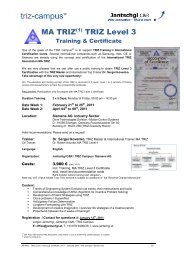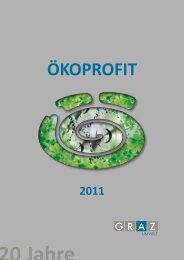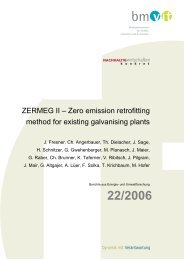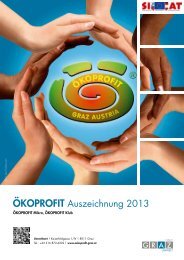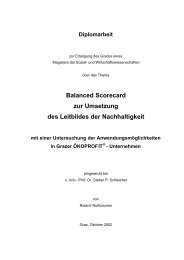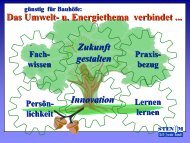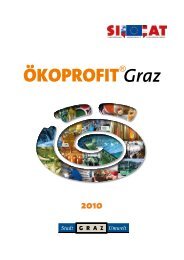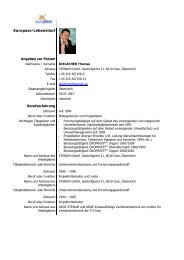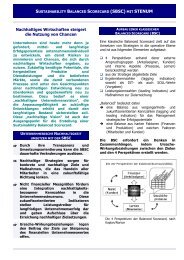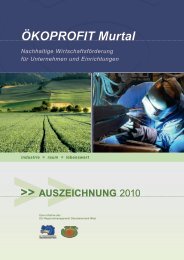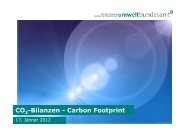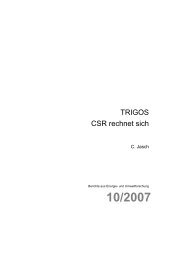Promoting Resource Efficiency in Small & Medium size ... - UNEP
Promoting Resource Efficiency in Small & Medium size ... - UNEP
Promoting Resource Efficiency in Small & Medium size ... - UNEP
Create successful ePaper yourself
Turn your PDF publications into a flip-book with our unique Google optimized e-Paper software.
European BREF notes are available for the follow<strong>in</strong>g sectors and crosssectoral<br />
topics 99 :<br />
• Cement, Lime and Magnesium Oxide Manufactur<strong>in</strong>g Industries<br />
• Ceramic Manufactur<strong>in</strong>g Industry<br />
• Chlor-Alkali Manufactur<strong>in</strong>g Industry<br />
• Common Wastewater and Waste Gas Treatment<br />
• Economics and Cross-Media Effects Emissions from Storage<br />
• Energy <strong>Efficiency</strong><br />
• Ferrous Metals Process<strong>in</strong>g Industry<br />
• Food, Dr<strong>in</strong>k and Milk Industries<br />
• General Pr<strong>in</strong>ciples of Monitor<strong>in</strong>g<br />
• Glass Manufactur<strong>in</strong>g Industry<br />
• Industrial Cool<strong>in</strong>g Systems<br />
• Intensive Rear<strong>in</strong>g of Poultry and Pigs<br />
• Large Combustion Plants<br />
• Large Volume Inorganic Chemicals – Ammonia, Acids and<br />
Fertiliser Industries<br />
• Large Volume Inorganic Chemicals – Solids and Others Industry<br />
• Large Volume Organic Chemical Industry<br />
• Management of Tail<strong>in</strong>gs and Waste-Rock <strong>in</strong> M<strong>in</strong><strong>in</strong>g Activities<br />
• Manufacture of Organic F<strong>in</strong>e Chemicals<br />
• M<strong>in</strong>eral Oil and Gas Ref<strong>in</strong>eries<br />
• Non-Ferrous Metals Industries<br />
• Production of Iron and Steel<br />
• BREF Production of Polymers<br />
• Production of Speciality Inorganic Chemicals<br />
• Pulp and Paper Industry<br />
• Slaughterhouses and Animals Byproducts Industries<br />
• Smitheries and Foundries Industry<br />
• Surface Treatment of Metals and Plastics<br />
• Surface Treatment Us<strong>in</strong>g Organic Solvents<br />
• Tann<strong>in</strong>g of Hides and Sk<strong>in</strong>s<br />
• Textiles Industry<br />
• Waste Inc<strong>in</strong>eration<br />
• Waste Treatments Industries<br />
For a unit-operation-based approach to benchmark<strong>in</strong>g, please refer<br />
to Chapter 5 (Energy <strong>Efficiency</strong>) for benchmarks on boilers, air<br />
compressors, etc. and to Chapter 4 (Water <strong>Efficiency</strong>) for benchmarks<br />
on clean<strong>in</strong>g.<br />
You might also want to relate your process to the ‘ideal’ process. For<br />
example: if you are heat<strong>in</strong>g billets before forg<strong>in</strong>g, calculate how much<br />
heat it takes to heat one billet from ambient air temperature to 800°C<br />
(heat is mass times specific heat times temperature difference), multiply<br />
by the number of billets per hour and compare to the fuel consumption<br />
per hour for your furnace.<br />
9.1 Benchmarks for the textile sector<br />
Table 22 gives benchmarks for the total water consumption (hot and<br />
cold) and hot water consumption of <strong>in</strong>dividual process steps for the<br />
production of cotton and viscose fabrics<br />
Pre-treatment Processes<br />
Water consumption (l/kg)<br />
TOTAL<br />
Of which HOT<br />
WATER<br />
Wash<strong>in</strong>g for desiz<strong>in</strong>g 3 – 4 3 – 4<br />
Wash<strong>in</strong>g after scour<strong>in</strong>g 4 – 5 4 – 5<br />
Wash<strong>in</strong>g after bleach<strong>in</strong>g 4 – 5 4 – 5<br />
Wash<strong>in</strong>g after cold bleach<strong>in</strong>g 4 – 6 4 – 6<br />
Wash<strong>in</strong>g after mercerisation<br />
- Wash<strong>in</strong>g to remove NaOH<br />
- Neutralisation without<br />
dry<strong>in</strong>g<br />
- Neutralisation and dry<strong>in</strong>g<br />
Wash<strong>in</strong>g after dye<strong>in</strong>g<br />
4 – 5 (hot)<br />
1 – 2 (cold)<br />
1 – 2 (warm)<br />
4 – 5<br />
n/a<br />
< 1<br />
Reactive dyestuffs 10 – 15 4 – 8<br />
Vat dyestuffs 8 – 12 3 – 7<br />
Sulphur dyestuffs 18 – 20 8 – 10<br />
Naphtol dyestuffs 12 – 16 4 – 8<br />
Table 22: Achievable specific water consumption levels for cont<strong>in</strong>uous<br />
wash<strong>in</strong>g processes dur<strong>in</strong>g f<strong>in</strong>ish<strong>in</strong>g of open width woven fabric consist<strong>in</strong>g of<br />
cotton or viscose and their blends with synthetic fibres<br />
Table 23 gives benchmarks for the total water consumption (hot and<br />
cold) and hot water consumption of <strong>in</strong>dividual dye<strong>in</strong>g processes for the<br />
production of cotton and viscose fabrics.<br />
Water consumption (l/kg)<br />
TOTAL<br />
Of which HOT<br />
WATER<br />
Reactive dyestuffs 15 – 20 12 – 16<br />
Vat dyestuffs 12 – 16 4 – 8<br />
Naphtol dyestuffs 14 – 18 6 – 10<br />
Disperse dyestuffs 12 – 16 4 - 8<br />
Table 23: Achievable specific water consumption levels for dye<strong>in</strong>g cotton and<br />
viscose<br />
To capture the optimisation opportunities that <strong>in</strong>ternal benchmark<strong>in</strong>g<br />
can offer, start record<strong>in</strong>g the daily consumption numbers for your<br />
enterprise and analyse the numbers over time. Ask your team: is<br />
consumption stable and at the level you would expect or does it vary?<br />
Are there days with lower consumption compared to the average? What<br />
can you learn from these days?<br />
99) European Commission, Jo<strong>in</strong>t Research Center, Reference documents, 2008<br />
90



